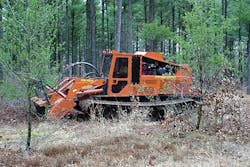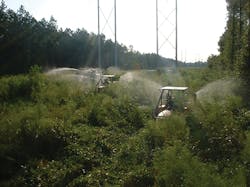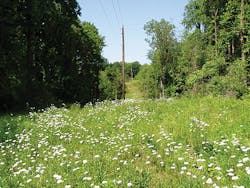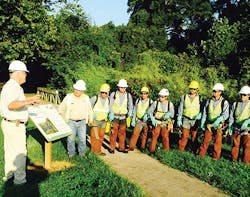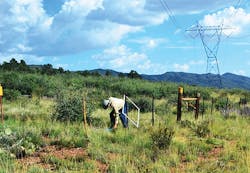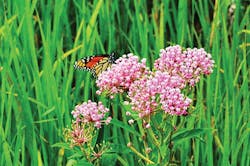Integrated vegetation management (IVM) is generally defined as the practice of promoting desirable, stable, low-growing plant communities — those that will resist invasion by tall-growing tree species — through the use of appropriate, environmentally sound and cost-effective control methods. These methods can include a combination of chemical, biological, cultural, mechanical and manual treatments. More in-depth, detailed definitions can be found in the U.S. Environmental Protection Agency’s IVM Fact Sheet and the ANSI A300 Part 7: Tree, Shrub and Other Woody Plant Maintenance Standard Practices.
The IVM approach strives to manage the environment by balancing the benefits of vegetation control, cost, public health, environmental quality and regulatory compliance. Adopting IVM on rights-of-way (ROW) can improve transmission reliability, reduce maintenance costs — thus, reducing the consumer’s cost — improve native plant and wildlife habitat, and provide other ecological benefits.
While the concept sounds simple enough, it takes trained professionals to put true IVM into practice. Many managers think they are practicing IVM by implementing low-volume herbicide applications, but that is like saying someone who uses a hammer is a carpenter. What follows are five imperatives of an IVM contract:
1. Planning and Training
Knowledge of land, vegetation, ecology and tools (and the methods of using them) is required. A written plan and a digital georeferenced map will go far in describing the work. However, the plan will fail without careful selection of the appropriate tools, knowledge of when and where to use them, and a predetermined expectation of results. Therefore, training or a qualified IVM contractor with expertise is necessary.
A written IVM plan, based on training and experience, is the first and perhaps most important imperative.
2. Diversity of Tools and Methods
A diversity of tools and methods allows for the selection of the most appropriate tool or method for the greatest effect on a particular site, while diminishing negative impacts. Because large and dense vegetation is difficult to manage, sites with these conditions likely will require an initial mechanical preparation or broadcast herbicide application. This will reduce the size and spacing of vegetation so individual plants can be targeted, or avoided, in the future. In sites with steep or rugged terrain, a chain saw, brush saw or bladed hand tool may be required.
Herbicide tools can be useful because they offer the ability to reduce stem density of problematic vegetation. Herbicide application methods that target specific plants can change the dynamics of the plant community by favoring the desirable ones. Careful prescription of selective herbicides with a proper dosage can further enhance the desirable plant community.
With the ecological concept of an old-field, or prairie, succession, native plants will prevail when using IVM methods. Many low-growing native plants are self-sustaining and require less input in future maintenance cycles. Native Americans recognized this ecological dynamic by prescribed burning every few years.
Once the desirable plants are favored, they tend to occupy and dominate the site. Many plants with innate properties called allelopathy will retard growth and development of competing, undesirable plants. In addition, by removing snags and perching sites for raptors, rabbits and voles suffer less predation and flourish in a grass-dominated ROW. Many of these small mammals will devour seeds and clip woody seedlings, which further delays the invasion of undesirable plants and prolongs the prairie succession.
3. Practical Experience
Being proficient in implementing a successful IVM program requires training and previous experience over several years and on varied geography. Proof of the successful implementation of IVM programs is the best reference for an IVM contractor.
4. Auditing
Every IVM program should begin with a vision of success and that success should be measured by a list of predetermined metrics that provide empirical documentation. Third-party auditing is a key part of the ROW Steward Accreditation program, and the ROW Stewardship Council offers governance and standards for reference.
5. Adjustments
Because biological systems tend to be complex, the interaction between soils, weather, invasive species, human intervention and other factors renders predictability difficult. An IVM contract that incorporates a planned second-year patrol is valuable insurance. In addition, the alternating use of tools and methods guards against the resistance or domination of undesirable plants. A qualified IVM contractor should have the ability to read these interactions.
Practicing IVM will control costs, benefit wildlife and enhance public relations. Implementing these five imperatives in IVM contracts should help utilities reap the rewards of an effective program and good ROW stewardship.
Lee Atkins is vice president and cofounder of Progressive Solutions, LLC. He has more than 37 years of experience in the forestry and utility industries. He is a base board member of the Mississippi Vegetation Management Association and the Professional Arborist Association of Mississippi. He holds a BS degree in biology and chemistry from the University of Southern Mississippi.
Editor’s note: The ROWSC, a group of utility forestry experts, conservationists and academia, named Dovetail Partners in Minneapolis, Minnesota, as the program administrator of the ROW Stewardship Accreditation program. For additional information on the program and its standards, visit www.dovetailinc.org/programs/land_use/rowsc or call (612) 333-0430.


